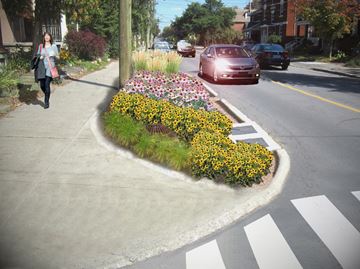Rain gardens being installed along Sunnyside Avenue
Ottawa East News, Nov 06, 2014
By Michelle Nash

New landscaping features being installed along Sunnyside Avenue aim to help better redistribute storm water in Old Ottawa South.
The “green street” measures on Sunnyside are a part of a larger project focused on creating traffic calming measures for the area, based on the Old Ottawa South area traffic management study, which was completed in 2012. Right now, construction is underway to narrow of the streets, add crosswalks and curb extensions.
Senior project manager Darlene Conway said the city added the idea to build “rain gardens” to the project to improve water quality and reduce runoff into the Rideau River.
“Really it’s the genesis between city staff,” Conway said. “(As part of) the study completed in 2012, we co-ordinated with that group because we wanted to do some storm water management because it’s an old neighbourhood and currently water goes into Rideau River untreated.”
According to the city, rain gardens are planted in areas designed to improve water quality and reduce run-off using a combination of soil, plants, and mulch to treat and absorb storm water run-off. They can be combined with boulevard extensions to serve multiple purposes, including traffic calming, improved aesthetics and storm water management.
There will be three rain gardens, one each at the intersection of Sunnyside and Leonard, Rosedale and Grosvenor avenues. The gardens will trap-capture dirt run-off from the road, which will be treated by the plants and soil and then can safely overflow into the sewer, eventually making its way to the Rideau River.
Conway said that up to 25 millimetres of rain can be treated at one time with the new gardens, which will allow for a bit of “ponding” and release slowly into the drain.
The gardens will be built within the approved traffic calming bulb-outs along Sunnyside.
“This has been made possible because of the other traffic calming measures on the streets,” Conway said.
A pilot project, these gardens will be monitored by Conway and staff over the course of two to three years to see just how successful they can be at treating road run-off.
Conway said this type of treatment has been done in other cities in Canada, but not in Ottawa.
“We have a different climate,” she said. “We haven’t done this thing before, so we will monitor them and track how well it performs.”
The city will test water quality, erosion and flooding impacts.
Conway said the gardens have also been designed to be able to sustain large amounts of snow during the winter.
The plants which will be placed in the gardens Conway said will be hearty, tall plants.
They will offer a bit of green to the streets and for the most part, Conway added most residents have approved of the project.
Residents’ approval is important, Conway said, because the goal is to find Old Ottawa South residents who will be interested in maintaining the garden after the pilot project is complete.
“It would depend on the time of year, but the work could include re-mulching, cutting back dead material in the spring and debris collection,” Conway said. “It would be minimal, but would have to be done at certain times of the year.”
If the pilot project proves to be successful, Conway said the city would look at other urban areas which could benefit from this type of retrofit along aging streets which were developed without proper storm water management.
“We are making a list of older neighbourhoods, inside the greenbelt, not the full area, but the older area which developed without storm water management,” Conway said.
A short section of storm sewer between Bronson Avenue and Sloan Avenue will also be replaced and a section of water main installed at the north end of Sloane Avenue.
The construction will be completed this season, including building the rain gardens but planting will not take place until the spring.
http://www.ottawacommunitynews.com/n...nyside-avenue/



